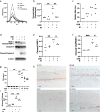Keratinocyte derived extracellular vesicles mediated crosstalk between epidermis and dermis in UVB-induced skin inflammation
- PMID: 39350252
- PMCID: PMC11441254
- DOI: 10.1186/s12964-024-01839-9
Keratinocyte derived extracellular vesicles mediated crosstalk between epidermis and dermis in UVB-induced skin inflammation
Abstract
Background and rationale: Ultraviolet-B (UVB) light induces dermal inflammation, although it is mostly absorbed in the epidermis. Recent reports suggest extracellular vesicles (EVs) act as a mediator of photodamage signaling. Melatonin is reported to be a protective factor against UV-induced damage. We hypothesized that EVs derived from UVB-irradiated keratinocytes might trigger proinflammatory responses in dermal cells and tested whether melatonin can ameliorate UVB-induced inflammation.
Methods: We used UVB-irradiated HaCaT cells, primary keratinocytes and STING knock-out mice to model production of EVs under photodamaging conditions and performed immunoblotting and ELISA to measure their effect on dermal macrophages.
Results: UVB-irradiated keratinocytes produce an increased number of EVs that contain higher concentrations of DNA and protein compared with controls. KC-derived EVs (KEVs) induced a STING- and inflammasome-mediated proinflammatory response in macrophages in vitro, and a pronounced inflammatory infiltrate in mouse dermis in vivo. Melatonin ameliorated KEVs inflammatory effect both in vitro and in vivo.
Conclusions: This data suggests EVs are mediators in a crosstalk that takes place between keratinocytes and their neighboring cells as a result of photodamage. Further studies exploring EVs induced by damaging doses of UVB, and their impact on other cells will provide insight into photodamage and may help develop targeted therapeutic approaches.
© 2024. This is a U.S. Government work and not under copyright protection in the US; foreign copyright protection may apply.
Conflict of interest statement
The authors declare no competing interests.
Figures






References
-
- Baka Z, Senolt L, Vencovsky J, Mann H, Simon PS, Kittel A, et al. Increased serum concentration of immune cell derived microparticles in polymyositis/dermatomyositis. Immunol Lett. 2010;128(2):124–30. - PubMed
-
- Bauwens E, Parée T, Meurant S, Bouriez I, Hannart C, Wéra AC, et al. Senescence induced by UVB in keratinocytes impairs amino acids balance. J Invest Dermatol. 2023;143(4):554–65. - PubMed
-
- Bennett MF, Robinson MK, Baron ED, Cooper KD. Skin immune systems and inflammation: protector of the skin or promoter of aging? J Investig Dermatol Symp Proc. 2008;13(1):15–9. - PubMed
MeSH terms
Substances
Grants and funding
LinkOut - more resources
Full Text Sources
Research Materials

